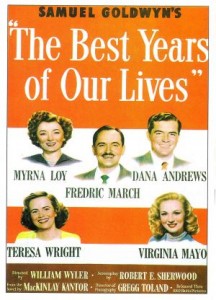Three wonderful loves in the best picture of the year!
At a crucial moment in one of the three pairs of relationships that form the plot in The Best Years of Our Lives, when Peggy Stephenson says to Fred Derry that she was hoping to prove that his kiss that afternoon in the cafeteria parking lot didn’t really happen, he replies, “But it did happen. It had to happen. And if we go on seeing each other, Peggy, it will happen again.” And so it had to happen in my musings on this site. Over these four years, I have covered, quite unconsciously, I assure you, all of my Top Ten favorite movies—except what is generally called, not only as a tag line but as fact, producer Samuel Goldwyn’s greatest picture.
It is, in fact, among the few films that move me emotionally—at least to the extent of tears, so hardened am I against the foreknowledge that what’s on that flat screen is all make-believe. In particular—and especially this, my favorite scene—there is Homer Parrish’s homecoming after war service in the U.S. Navy has cost him both hands, now replaced with prosthetic claws. Duffel bag in tow, he gets out of the cab and approaches the little white-framed house that is home.
“It’s Homer! It’s Homer!” shouts his younger sister (Marlene Aames), flinging open the front door and rushing to the next house to fetch his girlfriend, Wilma (Cathy O’Donnell in her film début). Including, now, his parents, all rush out to meet the returning war hero. They embrace him in turn, Wilma unnoticing or not caring about the new “hands.” Gregg Toland’s sharp camera somehow draws the viewers’ focus to his mother (Minna Gombell), who, standing back, draws her hands to her face, staring at those silver hooks and crying.
“It’s all right, Ma,” Homer says. “Don’t cry.”
“It’s—it’s nothing,” she replies.
His father (Walter Baldwin) speaks up. “It’s just that your Ma is so glad to see you home.”
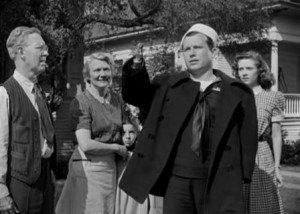 The depth of this already moving scene is further supported by Hugo Friedhofer’s music, adding a sympathetic and poignant accompaniment, though in clear understatement, that rings true as few scores do. Better known, even now, as an orchestrator for every composer in Hollywood at the time, most famously for the big sounds of Erich Wolfgang Korngold and Max Steiner, Friedhofer here, as throughout the film, has a smaller orchestra, more openly scored, almost Coplandish. As was the time-saving tradition in Hollywood, orchestrator though he was, Friedhofer did not orchestrate Best Years of Our Lives! Equally surprising, unlike most of his colleagues in the studio music departments, he was an American, born in San Francisco.
The depth of this already moving scene is further supported by Hugo Friedhofer’s music, adding a sympathetic and poignant accompaniment, though in clear understatement, that rings true as few scores do. Better known, even now, as an orchestrator for every composer in Hollywood at the time, most famously for the big sounds of Erich Wolfgang Korngold and Max Steiner, Friedhofer here, as throughout the film, has a smaller orchestra, more openly scored, almost Coplandish. As was the time-saving tradition in Hollywood, orchestrator though he was, Friedhofer did not orchestrate Best Years of Our Lives! Equally surprising, unlike most of his colleagues in the studio music departments, he was an American, born in San Francisco.
In Best Years of Our Lives, there are few melodies as such, certainly no ardent love theme; Friedhofer does write, however, a theme each for Wilma and for Al’s daughter. The rest of the score is a series of motifs that merge into a subtle uniformity, like a tightly woven tapestry, motifs associated with characters or circumstances. There are a number of ascending octave passages, most memorable in a frequent and uplifting chorale. The liveliest music—this serious drama little calls for such—occurs in the B-17 that is taking the three men home and during their taxi ride through town.
The plot of Best Years of Our Lives is straightforward, evenly and thoroughly dramatic, based on MacKinlay Kantor’s novel in free verse and fleshed out by screenwriter Robert E. Sherwood, about three servicemen returning home after World War II to the fictional Boone City (modeled on Cincinnati). During the film’s production, Sherwood and director [intlink id=”908″ type=”category”]William Wyler[/intlink] feared that the “even drama” lacked high points, certainly a climax, was vague-ended and too long. When a Long Beach sneak preview received overwhelming approval and extended applause, Goldwyn, who had had unreserved faith in his film throughout its creation, decided to leave it intact at two hours and forty-eight minutes.
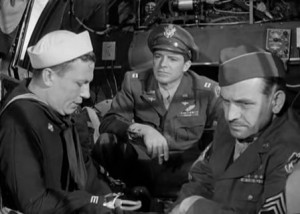 The returning veterans represent three branches of the service and three financial stratums. The one with the lowest rank, a seaman second class from a solidly middle class suburban home, is Homer Parrish (Harold Russell), who is returning to his parents and fiancée, Wilma. Referring to his physical disfigurement, he says, “She’s never seen anything like these hooks.”
The returning veterans represent three branches of the service and three financial stratums. The one with the lowest rank, a seaman second class from a solidly middle class suburban home, is Homer Parrish (Harold Russell), who is returning to his parents and fiancée, Wilma. Referring to his physical disfigurement, he says, “She’s never seen anything like these hooks.”
Russell would receive two awards that year—an Oscar as Best Supporting Actor and a special statuette “for bringing hope and courage to his fellow veterans through his appearance” in Best Years of Our Lives. Farley Granger was scheduled for the role, originally as a spastic, shell-shock victim, but that character would be problematic to portray and Wyler remembered an Army documentary featuring a young seaman without hands. The director was impressed by Russell’s expertise with his hooks: on screen, he removes a match from a matchbook and lights a cigarette, signs his name, lifts a glass of beer, cleans a rifle and puts the wedding ring on Wilma’s finger. So natural was his presence on screen that Wyler insisted he have no acting lessons.
Fred Derry ([intlink id=”688″ type=”category”]Dana Andrews[/intlink]), the highest in rank of the three men—a decorated Air Force (then U.S. Army-Air Force) captain on a B-17—is the lowest class in income, from the wrong side of the tracks. This is reinforced with not one but two scenes with a chug-chugging yard engine outside his parents’ shack. A soda jerk before the war, he hopes for better things but has to settle for a clerk behind a women’s cosmetic counter as well as a sundae-maker, then unemployment due to a fracas in the drug store.
He returns to a somewhat shallow and unloving wife, Marie (Virginia Mayo); she is having an affair with Cliff (Steve Cochran). It is clear at their reunion that they have little feelings for each other, perhaps a nod to the Production Code of the day to overlook—as it ultimately did due to Goldwyn’s stubborn defense of his movie—Fred’s infidelity with Peggy and her own pledge to break up the marriage. “I can’t stand it,” she tells her parents, “seeing Fred tied to a woman who doesn’t love him. Oh, it’s horrible for him. . . . Somebody’s got to help him.”
My extra attention given to Fred Derry is justified, because, among the three servicemen, the Fred/Peggy relationship emerges as the focal point of the film.
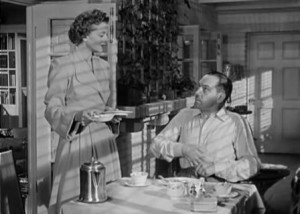 And the third serviceman is Al Stephenson ([intlink id=”316″ type=”category”]Fredric March[/intlink]), a former U.S. Army sergeant, slipping a bit uneasily into his former job as assistant vice president of a bank. Clearly upper class and living in a penthouse, he further has a drinking problem evident almost immediately. He returns to a forbearing wife, Milly ([intlink id=”576″ type=”category”]Myrna Loy[/intlink]), and two siblings. Their son is Rob (Michael Hall), their daughter Peggy ([intlink id=”1681″ type=”category”]Teresa Wright[/intlink], now in the last of four distinguished films, practically in a row).
And the third serviceman is Al Stephenson ([intlink id=”316″ type=”category”]Fredric March[/intlink]), a former U.S. Army sergeant, slipping a bit uneasily into his former job as assistant vice president of a bank. Clearly upper class and living in a penthouse, he further has a drinking problem evident almost immediately. He returns to a forbearing wife, Milly ([intlink id=”576″ type=”category”]Myrna Loy[/intlink]), and two siblings. Their son is Rob (Michael Hall), their daughter Peggy ([intlink id=”1681″ type=”category”]Teresa Wright[/intlink], now in the last of four distinguished films, practically in a row).
Definitely helping to make Best Years such a brilliant and, to this day, memorable film is Gregg Toland’s deep-focus photography, perhaps even more inventive than Friedhofer’s score. As with Toland’s work in Citizen Kane, there are numerous scenes where two activities transpire simultaneously, one in the foreground, one in the background—everything in focus!
In one scene, Al has called Fred to Butch’s bar to ask him if he is in love with Peggy and, if so, to force him never to see her again. “I haven’t called you a ‘bun’—yet,” he tells Fred. Fred does agree to renounce Peggy. In the foreground are Al, Butch (Hoagy Carmichael) and Homer (the latter two playing “Chopsticks” on the piano), and across the room, still in focus, Fred makes the required phone call to break up with Peggy.
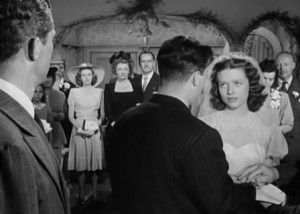 At the end of the film, the wedding of Homer and Wilma proceeds at foreground right with Fred standing foreground left, in a long-held shot. Fred stares at Peggy and she stares back from across the room. When he walks over to her, he tells her, “You know what it’ll be, don’t you, Peggy? It may take us years to get anywhere. We’ll have no money, no decent place to live. We’ll have to work, get kicked around.”
At the end of the film, the wedding of Homer and Wilma proceeds at foreground right with Fred standing foreground left, in a long-held shot. Fred stares at Peggy and she stares back from across the room. When he walks over to her, he tells her, “You know what it’ll be, don’t you, Peggy? It may take us years to get anywhere. We’ll have no money, no decent place to live. We’ll have to work, get kicked around.”
Among the jewels of Friedhofer’s nostalgic score, there is, of course, that already mentioned reunion with Homer’s family. Also, after Peggy has first met Fred and everyone has celebrated at Butch’s bar—Fred and Al get drunk—Fred returns home with the Stephensons; he sleeps in Peggy’s canopy bed, she on the couch in the living room. During the night, he has a nightmare, imagining he’s in a burning bomber: “It’s on fire! It’s on fire! Wing’s on fire! Bail out! She’s burning up!” The music, beginning from an almost lullaby calm, builds in an atonal, disjointed crescendo, simulating gunfire and crinkling flames, the horror graphic in a five-note ascending motif repeated incessantly in the strings. Peggy rubs his forehead, wipes the sweat from his face and recovers him with the bedspread. “It’s all right, Fred. It’s all right, Fred.”
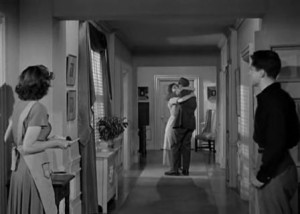 Another blending of deep-focus photography and music adds to the tender moment when Al returns home. At first, before entering the penthouse, he tells Fred the approaching reunion with his family is like “hitting a beach,” then rides anxiously up the elevator. After the subtlest of allusions in the orchestra to “Among My Souvenirs”—a special song between Al and Milly that will later accompany their dance in Butch’s bar—Al enters the hallway of his home. He stands camera left, with Milly on the right, busy beyond in the kitchen. “Who’s that at the door, Peggy?” she asks. “Peggy? . . . Rob? . . . Who is——?” She comes to meet him and they embrace in the hallway.
Another blending of deep-focus photography and music adds to the tender moment when Al returns home. At first, before entering the penthouse, he tells Fred the approaching reunion with his family is like “hitting a beach,” then rides anxiously up the elevator. After the subtlest of allusions in the orchestra to “Among My Souvenirs”—a special song between Al and Milly that will later accompany their dance in Butch’s bar—Al enters the hallway of his home. He stands camera left, with Milly on the right, busy beyond in the kitchen. “Who’s that at the door, Peggy?” she asks. “Peggy? . . . Rob? . . . Who is——?” She comes to meet him and they embrace in the hallway.
For those critics, perhaps some viewers, who have said or thought there is no climax in the film, they should remember that wordless stretch with Fred in the airplane graveyard, which was seen in the beginning of the film as the three men flew to Boone City in the B-17. Here Friedhofer and Toland, together, take front and center. As Fred, now unemployed and planning to leave town, walks past rows upon rows of upturned engines with propellers attached, a deep rumble erupts in the brass. Alfred Newman, who recommended Friedhofer to Goldwyn for Best Years, must have remembered this music when, four years later, he came to score the deserted airfield in the opening of 12 O’Clock High.
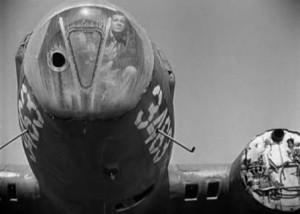 Next, Fred walks past disemboweled fighters, canopies and cockpits gone, noses to the ground, tails skyward, like some trounced animals. Then the long dolly shot is replaced by an overhead camera, lowering past war weary bombers and, finally, to one B-17 replete with many combat icons. Fred climbs in and sits in the bombardier’s plexiglas turret where he had spent many a mission, “on his knees” as he had told Al and Homer.
Next, Fred walks past disemboweled fighters, canopies and cockpits gone, noses to the ground, tails skyward, like some trounced animals. Then the long dolly shot is replaced by an overhead camera, lowering past war weary bombers and, finally, to one B-17 replete with many combat icons. Fred climbs in and sits in the bombardier’s plexiglas turret where he had spent many a mission, “on his knees” as he had told Al and Homer.
From outside again, Toland’s camera pans, in turn, to each of the flat, vacant disks where the four engines and their propellers had been, the music mimicking the sound of revving engines. Inside the turret, with a near-surreal shot of the airman’s silhouette against the dirty glass, Fred, at least in his mind, is back in the air with the roar of engines and the bursts of flak, reflected in the noise of the orchestra; those repeated ascending five notes from Fred’s nightmare return. The musical climax is interrupted by the salvage foreman (Pat Flaherty) on the ground. “Hey, you, what are you doing in that airplane?”
A special treat in this wonderful film—is there any doubt that I think so?!—is the presence of Hoagy Carmichael, or, as Goldwyn once called him during an award acceptance, “Hugo.” He plays the piano in a number of selections: “Toot, Toot, Tootsie (Goo’ Bye!),” “Beer Barrel Polka” and “Chopsticks.” Carmichael was Oscar-nominated that year for “Ole Buttermilk Sky,” with lyricist Jack Brooks, from Canyon Passage (also starring Dana Andrews), but he lost to Harry Warren and Johnny Mercer’s “On the Atchison, Topeka and Santa Fe.”
In a most memorable punch line—thanks to Carmichael—Homer has complained about how nervous his claw hands have made his family. As Butch plays a slow, soft take on “Up a Lazy River” (which, of course, Carmichael wrote), he calmly reassures Homer. “Give ’em time, kid. They’ll catch on. You know your folks’ll get used to you, and you’ll get used to them. Then everything’ll settle down nicely—unless we have another war.” Still speaking, Carmichael comes to the end of the song, with light, subtly spaced closing chords. “Then none of us have to worry, because we’ll all be blown to bits the first day. . . . So cheer up, huh?”
The Best Years of Our Lives is not, as some critics have written, a happy-ended film with all characters walking off into the sunset. Nothing so simplistic as that in this realistic and multi-layered film. It is painfully open-ended. It is unknown, for a starter, whether Al can maintain his marriage, made tenuous by his drinking, or that he can continue at the bank, with his arrogant boss (Ray Collins) and his over-generous loans to needy GIs. What about Homer? Though he seems the best adjusted of the three veterans despite his physical injury, will he prosper in his own marriage, being more concerned about his handicap than Wilma? And as for Fred and Peggy, the central pair of these three couples, it is uncertain how successfully they will navigate the rocky road ahead that Fred has envisioned.
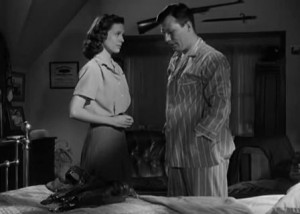 There’s much more that can be said about The Best Years of Our Lives. Maybe that’s why, though unconsciously, I think, I’ve waited so long to take this plunge, wondering if I would—could—do it justice. I still feel I haven’t. There’s left unmentioned, for example, that heart-wrenching scene, conceivably the emotional highlight of the film, where Homer shows Wilma how a handless man prepares for bed. But if you haven’t seen the film, that’s for you to discover and experience for yourself. And this belated appearance of Best Years among these musings isn’t because it’s the last of my Top Ten movies of all time—or, at least, my time. It isn’t.
There’s much more that can be said about The Best Years of Our Lives. Maybe that’s why, though unconsciously, I think, I’ve waited so long to take this plunge, wondering if I would—could—do it justice. I still feel I haven’t. There’s left unmentioned, for example, that heart-wrenching scene, conceivably the emotional highlight of the film, where Homer shows Wilma how a handless man prepares for bed. But if you haven’t seen the film, that’s for you to discover and experience for yourself. And this belated appearance of Best Years among these musings isn’t because it’s the last of my Top Ten movies of all time—or, at least, my time. It isn’t.
The film grossed around ten million dollars the first year of its release, second at the time only to Gone With the Wind, and received seven Academy Awards, including Best Picture, Best Director, Best Actor (March), Best Adapted Screenplay and Best Scoring of a Dramatic or Comedy Picture. When it was re-released in 1954, now adjusted to a CinemaScope format, it grossed another million.
There are many Samuel Goldwynisms. He was famous for them. One in particular is typical of the man’s sometimes irrational thinking and chaotic syntax—and it relates to Best Years. “I don’t care,” he said, “if it doesn’t make a nickel. I just want every man, woman and child in America to see it!”
